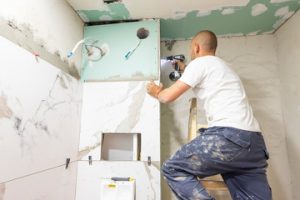During high wind, rain and hail storms, your roof can suffer damage that could lead to water leaks and other issues. Look for obvious signs like sagging areas, dents in your siding or shrubbery and water spots on the ceiling.

Get a ladder and go up into the attic to inspect your roof. It may seem daunting, but every day you wait is another day your roof gets worse. Visit Website to learn more.
The shingles on your roof serve as your home’s first line of defense against the elements. A worn or damaged shingle can weaken this defense and lead to water penetration, structural damage and even mold growth. Oftentimes, this is the first indication of a problem that can snowball into more costly issues like roof leaks. Whether it’s from storms, age or simply wear and tear, it is essential to address any shingle damage right away to prevent a small issue from becoming a major headache.
Shingles can be repaired with some simple tools and materials. In addition to the basic tools for roof repair—such as a hammer, flat pry bar and utility knife—you will also need a bundle of standard three-tab shingles in a color that matches your roof. If you have some leftover shingles from the last time your roof was worked on, they may be a good fit for the job (though be sure to inspect them carefully and remove any that are missing or curled). If not, you can buy a bundle at most home centers or lumberyards. The important thing is to have the shingles ready before you spot any damage, so that you can get them in place quickly and prevent further damage.
A shingle’s most common sign of trouble is cracking, which can be caused by extreme weather conditions or prolonged exposure to the sun’s UV rays. Each crack is a new entrance point for moisture and may lead to the need for more extensive repairs, such as leaks and potential water damage.
Another common symptom of deteriorating shingles is the presence of moss or plant growth. As these organisms grow, they can cling to the shingles and cause additional damage by trapping moisture and preventing the shingles from drying properly. To combat this, it’s important to regularly inspect the roof for moss and plant growth, as well as to maintain proper ventilation in the attic to keep moisture from building up.
A final common shingle problem is blistering, which can be caused by excessive heat or poor ventilation. This condition leads to the shingle’s outer layer melting, which exposes the underlayment and can result in a leaky roof. The good news is that blistering is an easy and relatively inexpensive fix, though the more widespread the damage, the more likely it is that a roof replacement will be necessary.
Damaged Flashing
Flashing is a metal barrier that prevents water from seeping into the attic and causing mold. It is located around roof edges, chimneys, vents, and skylights. Flashing is vulnerable to high winds and should be regularly inspected for signs of damage or wear.
Depending on the extent of the damage to your flashing, it may be possible for you to fix it yourself using roofing cement. However, it is always a good idea to call a roofer if there is any visible damage to the flashing. They will be able to climb up on your roof and evaluate the damage, look for collateral damage, and let you know what needs to be done to repair it.
If you are repairing your own flashing, make sure to use the correct type of flashing and roofing cement. You will also need to remove any damaged sections of the flashing, clean the area thoroughly, and apply a fresh layer of roofing cement. When replacing the flashing, it is a good idea to use galvanized steel flashing that is durable and corrosion-resistant.
When repairing roof flashing, you should also make sure to replace any shingles that were removed to get to the flashing. This will ensure that the shingles are properly aligned and secure, and that there are no gaps or loose areas where water could leak through. It is a good idea to apply a waterproof sealant to the entire area of the roof where the flashing is located, to ensure a tight and secure seal.
It is important to keep in mind that working on a roof can be dangerous, even for experienced homeowners. Attempting to repair the flashing on your roof without the proper experience can result in further damage to the roof and your property, as well as injury or even death. It is therefore important to have a professional roofer like Lyons Roofing inspect your roof and the flashing at least once per year, and to repair any damage promptly.
When you are repairing or replacing your roof flashing, it is important to document the process. This will help you keep track of the work that has been done, and can be useful for future reference or warranty claims. Be sure to take before-and-after pictures of the repairs, and keep a record of the materials used and any professional services that were hired. This will help you to avoid expensive repairs in the future, and it will also be beneficial for your home insurance claim should a claim need to be filed.
Missing Shingles or Tabs
Shingles form the first line of defense against rain, snow, wind and other environmental threats. Getting them repaired promptly after a storm will keep your home from suffering water damage. When shingles go missing, your roof’s underlayment becomes exposed and can allow water to seep into the insulation and cause mold growth and structural problems.
A shingle can be completely blown off by the wind, or it may only lose one of its tabs. This type of failure usually happens when the fasteners holding the shingle are pulled loose or weakened by wind. In some cases, the fasteners are not installed properly or they are made of poor quality materials that don’t hold up to weathering.
When only a single shingle tab is lost, it’s likely that the other tabs are still in place and the roof is safe. However, if the roof has been subjected to intense winds and the other tabs are also flipped up, it’s time to call in a professional roofing contractor.
Ideally, you should inspect your roof in the early morning after a big storm. Before getting up on your ladder, check the ground for shingle fragments that have fallen off. This will help you determine the extent of the roof damage, which components failed and why they failed.
You should also look for shingles that have been pushed up into the valleys. In some instances, the edges of a shingle are pushed up into the valleys and they can create gaps that let in moisture.
Another common problem is when the shingle’s adhesive strips are compromised. This can happen when the shingle’s protective granule layer is worn down, or it’s been exposed to harsh chemicals such as bleach or oil-based paints.
If you’re feeling confident and have some experience with DIY projects, it’s possible to patch a hole in your roof yourself by using a shingle strip that is the same size as the old one and then nailing it in place. It’s important to note that this is a temporary fix and you should have the damaged area inspected by a professional to avoid more expensive problems down the road.
Water Damage
Water damage from a roof leak can impact more than just the look and feel of your interior. It can cause problems with the foundation, walls, and ceilings of your structure, as well as affecting plumbing systems and electrical components. A leaking roof can also create mold and mildew, which pose health issues for you and your family. Water damage also compromises insulation, leading to higher energy bills. If you notice signs of a leaking roof, such as bubbled paint on the ceiling or walls or a musty smell in an upstairs room, you should call a professional right away.
It is possible to save some money on repair costs if you catch leaks early, before they do much damage. If you suspect a leak, start by checking easy-to-access areas, such as the attic or crawl space and looking for signs of moisture. Check for sagging spots in the attic or ceiling, and for wet areas around light fixtures, electrical boxes, or vents. You may need to replace drywall, insulation, or water supply lines that are affected by the leak.
Leaks can be caused by many different factors, including strong winds and large hail causing missing or damaged shingles and allowing water to seep into the attic or ceilings. Ice dams are another common culprit, forming when gutters become clogged and melting snow backs up under shingles. These issues can usually be prevented with regular maintenance and proper gutter cleaning and installation.
A professional roofer can inspect your home or business and find the source of the leak, and then make repairs as needed. They can also add protective barriers to prevent future damage and ensure the longevity of your roof and all of its components.
You should make a habit of regularly searching for leaks and other potential issues, especially after storms and on a consistent basis as the seasons change. In addition to preventing leaks, you can also lower your insurance rates if you have a quality roof and keep up with regular inspections.

